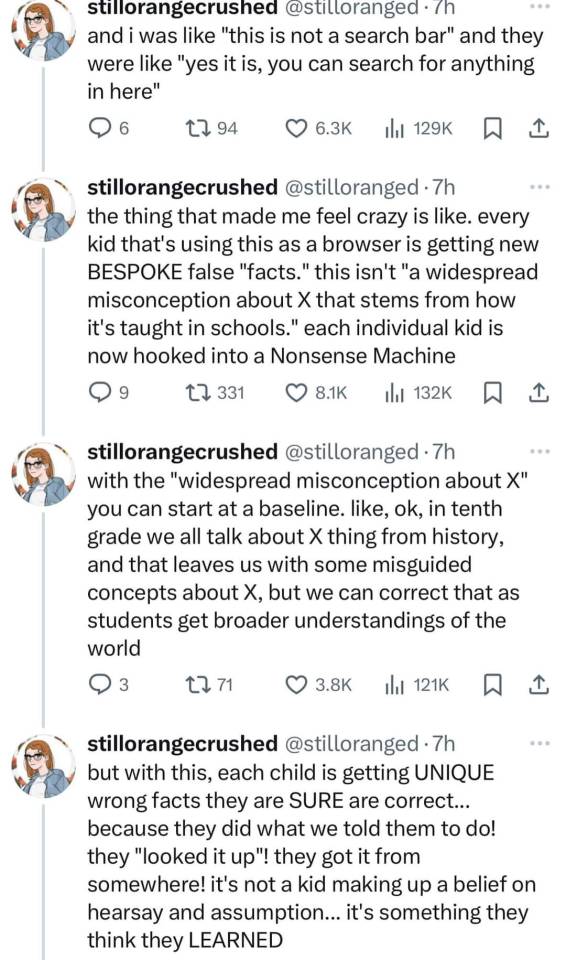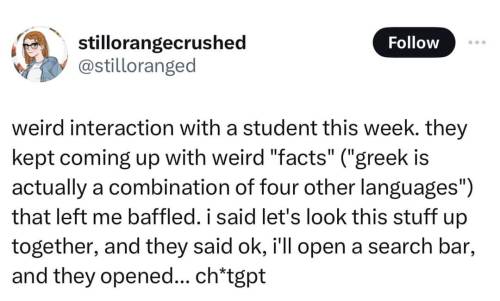Technologyinternetadminbrad - TECHNOLOGY INTERNET ADMIN BRAD



More Posts from Technologyinternetadminbrad and Others
"CVSS is a shitty system"
Esettanulmányok arról, hogy készül a virsli CVSS (Common Vulnerability Scoring System), a cURL vezető fejlesztőjének előadásában.
@muszeresz










cybersec:
“A secure cyberspace is critical to our prosperity.”
—
National Strategy for Trusted Identities in Cyberspace, Draft Final Report
http://www.whitehouse.gov/sites/default/files/rss_viewer/NSTICstrategy_041511.pdf



Really awesome command-line programs I've discovered on GitHub
I'm a data hoarder, so all of these have to do with downloading and saving media. I also use a Mac, so all of these are MacOS-compliant via Homebrew. If you also use a Mac (or Linux), do yourself a favor and install Homebrew via Terminal right now- all you need to do is copy-paste a line of code into Terminal and it will open you up to tons of awesome programs that normally only run on Windows.
Anyway, onto the list!
Yt-dlp (Youtube/Video downloader): On top of letting you rip Youtube videos directly from the site, this program supports a huge array of other video/media websites. The program is highly customizable as well; I would highly recommend at least installing FFmpeg, which allows you to download videos in quality higher than the default 720p. Here's a guide on how to do that for Windows and I wrote a guide here for Mac (I forgot to write in the guide that you should install FFmpeg via Homebrew).
Mangadex-dl (Mangadex downloader): Allows you to download manga directly from Mangadex, the hub of scanlation. Like yt-dlp it is customizable and you can pick which chapters you want to download (useful if you only want to download current chapters you haven't gotten before).
Gallery-dl (Bulk image downloading): A godsend for an art-hoarder like me, this program allows you to bulk download things like Pixiv pages, Twitter galleries, Deviantart galleries, Instagram pages, etc. Like yt-dlp it is highly customizable. Some websites (like Pixiv) may require user authentication; the GitHub page outlines the steps each authentication process requires.
List of other command line programs you might find interesting on GitHub
I'm sure I'll add to this list as I find more cool stuff on GitHub!

EXACTO READ DAVID
BRIDGE - BELL TOLLS - THE SMELL OF TOBACCO - AUTOMAT - MOVIE THEATER POPCORN - NEWSSTANDS - ULTRA - BIER - CERVEZA - CHAOS ENGINES - COMICCON COMIC-CON COMIC CON TAL SHIAR BATLETH OREOS
Key Differences Between AI and Human Communication: Mechanisms, Intent, and Understanding
The differences between the way an AI communicates and the way a human does are significant, encompassing various aspects such as the underlying mechanisms, intent, adaptability, and the nature of understanding. Here’s a breakdown of key differences:
1. Mechanism of Communication:
AI: AI communication is based on algorithms, data processing, and pattern recognition. AI generates responses by analyzing input data, applying pre-programmed rules, and utilizing machine learning models that have been trained on large datasets. The AI does not understand language in a human sense; instead, it predicts likely responses based on patterns in the data.
Humans: Human communication is deeply rooted in biological, cognitive, and social processes. Humans use language as a tool for expressing thoughts, emotions, intentions, and experiences. Human communication is inherently tied to understanding and meaning-making, involving both conscious and unconscious processes.
2. Intent and Purpose:
AI: AI lacks true intent or purpose. It responds to input based on programming and training data, without any underlying motivation or goal beyond fulfilling the tasks it has been designed for. AI does not have desires, beliefs, or personal experiences that inform its communication.
Humans: Human communication is driven by intent and purpose. People communicate to share ideas, express emotions, seek information, build relationships, and achieve specific goals. Human communication is often nuanced, influenced by context, and shaped by personal experiences and social dynamics.
3. Understanding and Meaning:
AI: AI processes language at a syntactic and statistical level. It can identify patterns, generate coherent responses, and even mimic certain aspects of human communication, but it does not truly understand the meaning of the words it uses. AI lacks consciousness, self-awareness, and the ability to grasp abstract concepts in the way humans do.
Humans: Humans understand language semantically and contextually. They interpret meaning based on personal experience, cultural background, emotional state, and the context of the conversation. Human communication involves deep understanding, empathy, and the ability to infer meaning beyond the literal words spoken.
4. Adaptability and Learning:
AI: AI can adapt its communication style based on data and feedback, but this adaptability is limited to the parameters set by its algorithms and the data it has been trained on. AI can learn from new data, but it does so without understanding the implications of that data in a broader context.
Humans: Humans are highly adaptable communicators. They can adjust their language, tone, and approach based on the situation, the audience, and the emotional dynamics of the interaction. Humans learn not just from direct feedback but also from social and cultural experiences, emotional cues, and abstract reasoning.
5. Creativity and Innovation:
AI: AI can generate creative outputs, such as writing poems or composing music, by recombining existing patterns in novel ways. However, this creativity is constrained by the data it has been trained on and lacks the originality that comes from human creativity, which is often driven by personal experience, intuition, and a desire for expression.
Humans: Human creativity in communication is driven by a complex interplay of emotions, experiences, imagination, and intent. Humans can innovate in language, create new metaphors, and use language to express unique personal and cultural identities. Human creativity is often spontaneous and deeply tied to individual and collective experiences.
6. Emotional Engagement:
AI: AI can simulate emotional engagement by recognizing and responding to emotional cues in language, but it does not experience emotions. Its responses are based on patterns learned from data, without any true emotional understanding or empathy.
Humans: Human communication is inherently emotional. People express and respond to emotions in nuanced ways, using tone, body language, and context to convey feelings. Empathy, sympathy, and emotional intelligence play a crucial role in human communication, allowing for deep connections and understanding between individuals.
7. Contextual Sensitivity:
AI: AI's sensitivity to context is limited by its training data and algorithms. While it can take some context into account (like the previous messages in a conversation), it may struggle with complex or ambiguous situations, especially if they require a deep understanding of cultural, social, or personal nuances.
Humans: Humans are highly sensitive to context, using it to interpret meaning and guide their communication. They can understand subtext, read between the lines, and adjust their communication based on subtle cues like tone, body language, and shared history with the other person.
8. Ethical and Moral Considerations:
AI: AI lacks an inherent sense of ethics or morality. Its communication is governed by the data it has been trained on and the parameters set by its developers. Any ethical considerations in AI communication come from human-designed rules or guidelines, not from an intrinsic understanding of right or wrong.
Humans: Human communication is deeply influenced by ethical and moral considerations. People often weigh the potential impact of their words on others, considering issues like honesty, fairness, and respect. These considerations are shaped by individual values, cultural norms, and societal expectations.
The key differences between AI and human communication lie in the underlying mechanisms, the presence or absence of intent and understanding, and the role of emotions, creativity, and ethics. While AI can simulate certain aspects of human communication, it fundamentally operates in a different way, lacking the consciousness, experience, and meaning-making processes that characterize human interaction.
-
 nobelnum liked this · 1 week ago
nobelnum liked this · 1 week ago -
 rileytheperson liked this · 1 week ago
rileytheperson liked this · 1 week ago -
 thismachinefucksguitars reblogged this · 1 week ago
thismachinefucksguitars reblogged this · 1 week ago -
 barbiesplasticskeleton liked this · 1 week ago
barbiesplasticskeleton liked this · 1 week ago -
 bard-of-cat liked this · 1 week ago
bard-of-cat liked this · 1 week ago -
 the-greatest-sun reblogged this · 1 week ago
the-greatest-sun reblogged this · 1 week ago -
 the-greatest-sun liked this · 1 week ago
the-greatest-sun liked this · 1 week ago -
 koolkobold reblogged this · 1 week ago
koolkobold reblogged this · 1 week ago -
 peachypawzz liked this · 1 week ago
peachypawzz liked this · 1 week ago -
 littlemissscatterbrained reblogged this · 1 week ago
littlemissscatterbrained reblogged this · 1 week ago -
 r3m1m0nk3y liked this · 1 week ago
r3m1m0nk3y liked this · 1 week ago -
 maudeivorystan liked this · 1 week ago
maudeivorystan liked this · 1 week ago -
 thejbomb liked this · 1 week ago
thejbomb liked this · 1 week ago -
 booksandtravel reblogged this · 1 week ago
booksandtravel reblogged this · 1 week ago -
 boneschrist liked this · 1 week ago
boneschrist liked this · 1 week ago -
 jelly-donuts-lover liked this · 1 week ago
jelly-donuts-lover liked this · 1 week ago -
 milquetoastl reblogged this · 1 week ago
milquetoastl reblogged this · 1 week ago -
 tails-is-cool reblogged this · 1 week ago
tails-is-cool reblogged this · 1 week ago -
 what-do-i-type-here liked this · 1 week ago
what-do-i-type-here liked this · 1 week ago -
 lovelylilacs310 liked this · 1 week ago
lovelylilacs310 liked this · 1 week ago -
 omarlit liked this · 2 weeks ago
omarlit liked this · 2 weeks ago -
 kokocactus liked this · 2 weeks ago
kokocactus liked this · 2 weeks ago -
 dontasktherain liked this · 2 weeks ago
dontasktherain liked this · 2 weeks ago -
 snow-bees liked this · 2 weeks ago
snow-bees liked this · 2 weeks ago -
 bowlingalleyarcadecarpet liked this · 2 weeks ago
bowlingalleyarcadecarpet liked this · 2 weeks ago -
 kores-korner liked this · 2 weeks ago
kores-korner liked this · 2 weeks ago -
 pure-frosting reblogged this · 2 weeks ago
pure-frosting reblogged this · 2 weeks ago -
 masterofalldumplings liked this · 2 weeks ago
masterofalldumplings liked this · 2 weeks ago -
 kemspeckle reblogged this · 2 weeks ago
kemspeckle reblogged this · 2 weeks ago -
 waterlelier liked this · 2 weeks ago
waterlelier liked this · 2 weeks ago -
 norahjakobs reblogged this · 2 weeks ago
norahjakobs reblogged this · 2 weeks ago -
 katarrinsreblogs liked this · 2 weeks ago
katarrinsreblogs liked this · 2 weeks ago -
 sweetteachai reblogged this · 2 weeks ago
sweetteachai reblogged this · 2 weeks ago -
 sweetteachai liked this · 2 weeks ago
sweetteachai liked this · 2 weeks ago -
 bookgently reblogged this · 2 weeks ago
bookgently reblogged this · 2 weeks ago -
 bookgently liked this · 2 weeks ago
bookgently liked this · 2 weeks ago -
 skepsiss reblogged this · 2 weeks ago
skepsiss reblogged this · 2 weeks ago -
 thewhiteandblackpencils reblogged this · 2 weeks ago
thewhiteandblackpencils reblogged this · 2 weeks ago -
 roaringdinosaur liked this · 2 weeks ago
roaringdinosaur liked this · 2 weeks ago -
 minakatana reblogged this · 2 weeks ago
minakatana reblogged this · 2 weeks ago -
 captain-castaway reblogged this · 2 weeks ago
captain-castaway reblogged this · 2 weeks ago -
 jackofallblades reblogged this · 2 weeks ago
jackofallblades reblogged this · 2 weeks ago -
 jackofallblades liked this · 2 weeks ago
jackofallblades liked this · 2 weeks ago -
 mlovespawn liked this · 2 weeks ago
mlovespawn liked this · 2 weeks ago -
 officialhoneynutcheerios liked this · 2 weeks ago
officialhoneynutcheerios liked this · 2 weeks ago -
 siarune liked this · 2 weeks ago
siarune liked this · 2 weeks ago -
 strawbxx-blog liked this · 2 weeks ago
strawbxx-blog liked this · 2 weeks ago

